Dental implantation

Nowadays, dental implantation is the most demanded and at the same time the most effective method of dental prosthetics.
Dental implantation involves the complete or partial restoration of the dental arch. It is a complex dental procedure performed in several stages and requires preparatory measures. Artificial roots are implanted into the upper and/or lower jaw, on which crowns are installed. The result is an exact imitation of a natural dental arch. Additionally, both removable and fixed dentures can be installed on implants.
Implantation is a complex, step-by-step procedure that, depending on various factors (particularly the condition of the bone tissue), can be performed either immediately after tooth extraction or 1.5-2 months later. In the first stage, the implant, acting as the tooth root, is inserted into the jawbone, usually made of titanium. Implant osseointegration may take 3 to 6 months, during which a temporary denture can be installed at the patient’s request.
Indications for implantation:
- Missing one tooth: implantation preserves adjacent teeth as they don’t need to be filed down for a crown.
- Missing two or three teeth in a row: implants help preserve adjacent teeth.
- Missing teeth at the end of the dental arch: implants are simpler to install compared to other prosthetic methods that require adjacent teeth as support.
- Complete absence of teeth: although not an absolute indication, implants can be more convenient than managing full removable dentures.
- Intolerance to dentures.

Patients undergoing implantation should be prepared for a long process requiring serious preparation. Oral cavity sanitation and treatment of problematic teeth are mandatory. Patients undergo CT scans to measure bone dimensions and determine implant placement. If there are contraindications, consultations with other specialists at Sigma Dent may be required.
To enhance recovery, we recommend plasma therapy during dental implantation. Plasma therapy is used effectively in surgical and therapeutic dentistry, periodontics, and dental implantation. The patient’s platelet-rich plasma is injected into the gum tissues around the implant, accelerating recovery and reducing the risk of rejection.
Once preparation is complete, the implant is surgically placed, followed by the installation of a crown. Successful implantation requires bone integration with the implant, a process known as osseointegration.
Main stages of implantation:
- Consultation with a dental surgeon-implantologist.
- Examination: bone tissue diagnostics, tests.
- Surgical stage: implant placement.
- Implant healing: 4 months (monthly check-ups).
- Updated smile: crown placement on the implant.

